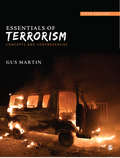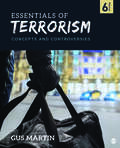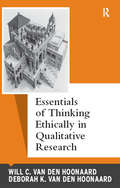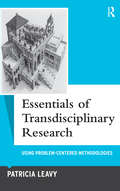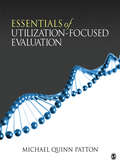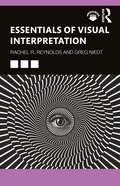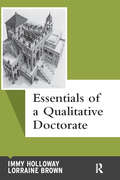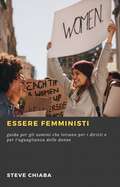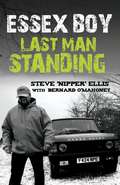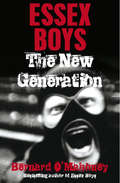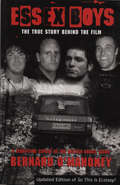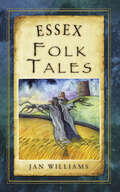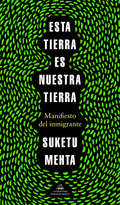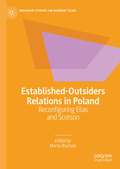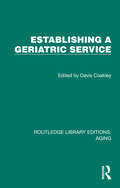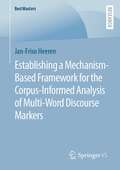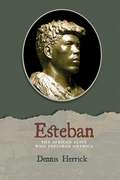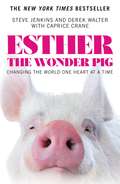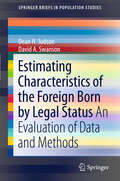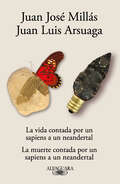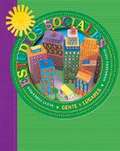- Table View
- List View
Essentials of Terrorism: Concepts and Controversies
by Gus MartinCaptivating, concise, and current, Essentials of Terrorism: Concepts and Controversies introduces readers to the modern landscape of domestic and international terrorism. The Fifth Edition of Gus Martin’s renowned text covers key foundational topics and provides a framework for defining terrorism and exploring its history and causes while also discussing terrorist environments, tactics, targets, and counterterrorism. This new edition includes information regarding intelligence, counterterrorism laws, and deprivation theory, as well as new and updated sections discussing mass violence in the United States, narco-terrorism, anti-state dissident terrorism, ISIS, and a new theoretical model for ending terrorist campaigns. The text also examines recent attacks and presents new data, case studies, and photos to show readers the state of terrorism across the globe today.
Essentials of Terrorism: Concepts and Controversies
by Gus MartinCaptivating, concise, and accessible, Essentials of Terrorism: Concepts and Controversies covers key foundational topics by defining terrorism and introducing its history and causes. Author Gus Martin introduces readers to the modern landscape of terrorism and discusses terrorist environments (domestic, international, religious, etc.), as well as tactics, targets, and counterterrorism. Included in the Sixth Edition is an added focus on U.S. hate crimes and homeland security, in addition to new introductory discussions, information, and data throughout each chapter.
Essentials of Terrorism: Concepts and Controversies
by Gus MartinCaptivating, concise, and accessible, Essentials of Terrorism: Concepts and Controversies covers key foundational topics by defining terrorism and introducing its history and causes. Author Gus Martin introduces readers to the modern landscape of terrorism and discusses terrorist environments (domestic, international, religious, etc.), as well as tactics, targets, and counterterrorism. Included in the Sixth Edition is an added focus on U.S. hate crimes and homeland security, in addition to new introductory discussions, information, and data throughout each chapter.
Essentials of Thinking Ethically in Qualitative Research (Qualitative Essentials #10)
by Will C van den Hoonaard Deborah K van den HoonaardEthical dimensions of qualitative research are constantly emerging and shifting. This volume identifies relevant ethical principles that can guide novice researchers through the research process with the necessary wisdom and insight to shape a project in sound, meaningful, and thoughtful ways. Well known for their work in this area, the van den Hoonaards outline the domains on which ethics most often impinge. They address key ethical issues arising in different qualitative traditions and contexts. The volume concludes with guidance on how to navigate formal ethics reviews. Many key examples and other resources help the student engage the complicated literature on this topic.
Essentials of Transdisciplinary Research: Using Problem-Centered Methodologies (Qualitative Essentials #6)
by Patricia LeavyTransdisciplinary research is issue-driven, addressing contemporary social questions from a range of critical theoretical perspectives unhampered by the theoretical and methodological restrictions of traditional disciplinary boundaries. In this brief, informative guide, Patricia Leavy shows how a transdisciplinary approach can produce more effective results for researchers hoping to ameliorate social problems and foster social justice. Leavy demonstrates the value of transdisciplinary approaches in mixed methods design, and how trans approaches actually help fulfill the promises and goals of mixed methods research. She explains its relationship to multi-disciplinary and interdisciplinary research and its value in community-based and arts-based research projects. Providing the key principles and methods needed to conduct a transdisciplinary study, Leavy also offers numerous examples from multiple research sectors to show its effectiveness. Ideal as a brief introductory text for students engaged in this style of research.
Essentials of Utilization-Focused Evaluation
by Michael Quinn PattonBased on Michael Quinn Patton′s best-selling Utilization-Focused Evaluation, this briefer book provides an overall framework and essential checklist steps for designing and conducting evaluations that actually get used. The new material and innovative graphics present the utilization-focused evaluation process as a complex adaptive system, incorporating current understandings about systems thinking and complexity concepts. The book integrates theory and practice, is based on both research and professional experience, and offers new case examples and cartoons with Patton′s signature humor.
Essentials of Utilization-Focused Evaluation
by Michael Quinn PattonBased on Michael Quinn Patton′s best-selling Utilization-Focused Evaluation, this briefer book provides an overall framework and essential checklist steps for designing and conducting evaluations that actually get used. The new material and innovative graphics present the utilization-focused evaluation process as a complex adaptive system, incorporating current understandings about systems thinking and complexity concepts. The book integrates theory and practice, is based on both research and professional experience, and offers new case examples and cartoons with Patton′s signature humor.
Essentials of Visual Interpretation
by Greg Niedt Rachel R ReynoldsEssentials of Visual Interpretation explains how to talk and write critically about visual media and to examine how evolving visual environments, media, and technologies affect human selfunderstanding and culture formation. Lively and accessibly written chapters provide a solid foundation in the tools and ideas of visual meaning, familiarizing readers with a growing, cross-cultural subfield, and preparing them to pursue thoughtful work in a variety of related disciplines. The authors include rich examples and illustrations—ranging from cave paintings to memes, from optical science to visual analytics, from ancient pictographs to smart phones—that engage students with the fascinating complexity of visual interpretation. Each chapter introduces students to key terms and concepts relevant to visual analysis, with ideas for short individual or group exercises to enhance understanding. The book is ideal as a primer in visual analysis and visual communication for students in courses within communication studies, cultural studies, digital humanities, semiotics, media studies, and visual anthropology. Online support materials include multimedia activities for students and links to additional resources for students and instructors.
Essentials of Visual Interpretation
by Greg Niedt Rachel R ReynoldsEssentials of Visual Interpretation explains how to talk and write critically about visual media and to examine how evolving visual environments, media, and technologies affect human selfunderstanding and culture formation.Lively and accessibly written chapters provide a solid foundation in the tools and ideas of visual meaning, familiarizing readers with a growing, cross-cultural subfield, and preparing them to pursue thoughtful work in a variety of related disciplines. The authors include rich examples and illustrations—ranging from cave paintings to memes, from optical science to visual analytics, from ancient pictographs to smart phones—that engage students with the fascinating complexity of visual interpretation. Each chapter introduces students to key terms and concepts relevant to visual analysis, with ideas for short individual or group exercises to enhance understanding.The book is ideal as a primer in visual analysis and visual communication for students in courses within communication studies, cultural studies, digital humanities, semiotics, media studies, and visual anthropology.Online support materials include multimedia activities for students and links to additional resources for students and instructors.
Essentials of a Qualitative Doctorate (Qualitative Essentials #8)
by Immy Holloway Lorraine BrownHave you been working toward a qualitative doctorate without a guide? Immy Holloway and Lorraine Brown are here to help. Breaking down the process step by step, this book gives essential advice on navigating the whole program. You’ll first get some tips on selecting a research topic and writing a proposal. From there, you’ll receive guidance on your research journey, all the way through the completion (and publication!) of your dissertation. Also included is a helpful recommended reading list broken down by research area. This book is an excellent resource for doctoral students of qualitative research and for those who are still considering whether to make the leap.
Essere femministi: guida per gli uomini che lottano per i diritti e per l’uguaglianza delle donne
by Steve ChiabaDescrizione del libro Guida per gli uomini al femminismo moderno. Siete mai stati vittime di violenza, odio, molestie o sofferenze a causa del vostro sesso? Essere femministi o mettere in pratica ideali femministi significa lottare per le cose che contano. Si parla di argomenti quali parità di retribuzione, maternità, diritti riproduttivi, violenza domestica, diritto a essere trattati con rispetto. Se volete sapere di più su come lottare per i propri diritti e come supportare la lotta per i diritti delle donne questa è la guida per voi. Apprendere ad essere femministi; Imparare a far valere i propri diritti; Battersi per l’uguaglianza e la pari retribuzione; Tanto altro ancora. Apprendere ad essere dalla parte giusta della storia dando il proprio contributo laddove è più necessario. Scorrete in cima alla pagina cliccando sulla voce ‘aggiungi al carrello’ per acquistare immediatamente.
Essex Boy: Last Man Standing
by Steven Ellis Bernard O'MahoneyTwo films and numerous books have attempted to tell the shocking story of two of Britain's most ruthless gangs. For 20 years, the Essex Boys firm and their successors, the New Generation, controlled a lucrative drugs empire in Essex and throughout the south east of England by using intimidation, gratuitous violence and murder. Rampaging through the streets and clubland, they destroyed anything and anybody that dared to get in their way. Eventually torn apart by greed and paranoia, the gang members became victims of their own vile trade and hate-filled actions. Pat Tate, Tony Tucker and Craig Rolfe were all blasted repeatedly with a shotgun as they sat in their Range Rover down a remote farm track. Dean Boshell was lured to allotments, then beaten and shot execution-style three times through the head. Others, such as Darren Nicholls and Damon Alvin, turned Super Grass and disappeared into the witness protection scheme never to be seen again, while three other men are in prison serving life sentences. Steve `Nipper` Ellis is the last man standing, the only member to have survived the bloody reign of both gangs. In Essex Boy, he tells his shocking story for the first time, and reveals just how close he came to being both murderer and murder victim.
Essex Boys, The New Generation
by Bernard O'MahoneyIn December 1995, three key members of the infamous Essex Boys firm were executed in their Range Rover after being lured to a deserted farm track by the promise of a lucrative drug deal. The police predicted that the void left as a result of the murders would cause a gangland war that would extend across London and much of the south-east.Essex Boys, The New Generation tells the chilling true story of the gang that destroyed everything that stood in their way to take control of their fallen predecessors' drug empire. With a reputation for ruthless violence, the gang expanded and protected their drug-dealing operation with a terrifying combination of bloodshed and intimidation.In February 2001, tensions within their circle boiled over and resulted in one member being shot dead. The police investigation was met with a wall of silence and for three years it seemed as if the case would remain unsolved. A leading member of the gang was eventually charged, but in an unexpected twist he became the prosecution's star witness. While a murder conviction was finally secured, the real truth surrounding the murder and the gang's psychotic crimes has never been revealed.Now, for the first time, former Essex Boys member Bernard O'Mahoney tells the full, extraordinary story of the rise and fall of the gang that took over the Essex underworld from him and his associates.
Essex Boys: A Terrifying Expose Of The British Drugs Scene
by Bernard O'MahoneyESSEX BOYS is the brand new edition of the shocking bestseller known as SO THIS IS ECSTASY?. It is the true story of the rise of one of the most violent and successful criminal gangs of the 90's whose reign of terror was finally terminated when the three leaders were brutally murdered in their Range Rover one winter's evening. On their way they had built the drug-dealing organisation that which supplied the pill that killed Leah Betts. They were responsible for a wave of intimidation, beatings and murder. Until, it seems, they took one step too far. Now there is compelling evidence that the men convicted of shooting the dead men are innocent. Which means the real murderers are still at large. Bernard O'Mahoney was a key member of what has been one of the most feared gangs of the decade. His inside account of their cold-blooded violence reveals that facts can be more terryfing than fiction.
Essex Folk Tales (Folk Tales: United Kingdom)
by Jan WilliamsThe Essex coastline has endured invasion by plundering and bloodthirsty Romans, Anglo-Saxons and Vikings, and this mysterious landscape is still haunted by their presence. Their spirits, and countless others, have oft been reported – not least by smugglers determined to keep intruders away from their secret hideouts. Even more dramatic stories of the supernatural lurk inland: accusations of witchcraft have been screamed around many picturesque market towns, dragons have terrorised the community, and a violent White Lady has struck at Hadleigh Castle. Indeed, it is the women of Essex who have stirred the imagination most – from brave Boudicca and beautiful Edith Swan-neck to the adulteress Kitty Canham. Amid the county’s infamous pirates, highwaymen and desperados, Essex can even boast a lady smuggler.
Esta tierra es nuestra tierra: Manifiesto del inmigrante
by Suketu MehtaEl aclamado autor de Ciudad total, Suketu Mehta, firma un apasionado ensayo narrativo a favor de la inmigración global. «Un libro brillante, urgente y necesario. Una elocuente defensa de nosotros, los inmigrantes, contra la intolerancia: qué no somos, quiénes somos, por qué nos merecemos ser bienvenidos y no temidos.»Salman Rushdie Mas que nunca antes, gran parte de la población global se ve obligada a abandonar su hogar y emigrar. Suketu Mehta se encuentra entre los millones de personas que se han visto forzadas a vivir en un país en el que no han nacido, y Esta tierra es nuestra tierra es su urgente defensa de la inmigración global. Un manifiesto a favor de la empatía en el que expone que Occidente no está siendo destruido por la llegada de inmigrantes desde áreas empobrecidas, sino por el miedo a la inmigración. Mehta contrasta las hipócritas narrativas de las ideologías populistas con el heroísmo cotidiano de trabajadores que emigran desde Latinoamérica o el Magreb hacia Occidente en busca de una mejora en sus condiciones de vida. Desde la experiencia de su propia familia, que tuvo que dejar India para trasladarse primero a Reino Unido y después a Estados Unidos, Mehta somete el rechazo a la inmigración a un escrutinio implacable y explora los destructivos legados del colonialismo y la desigualdad que asolan a una gran parte de los habitantes del planeta. Pasional, riguroso y nutrido por un amplio abanico de historias personales, Esta tierra es nuestra tierra es una oportuna y necesaria intervención en un debate de absoluta vigencia. Reseñas:«Una ferviente visión panorámica de la inmigración, revela los orígenes de la inmigración en masa con lucidez abrasadora.»The New York Times «Una crítica avasalladora contra la retórica antiinmigración que ha dominado la política global estos últimos años [...]. Mehta desmantela las narrativas de los ideólogos populistas con una defensa vehemente de la inmigración.»Time Magazine «Una crítica implacable a la hipocresía antiinmigratoria [...]. Conmovedor y ameno, es un himno para todos nosotros.»Jumpa Lahiri «Una llamada a la cordura y a la justicia escrita por uno de nuestros mejores autores.»Mohsin Hamid «Una declaración empática a favor de los inmigrantes que desvela las profundas fuerzas que los llevan a dejar sus hogares.»Joseph Stiglitz «Suketu Mehta es uno de los mejores pensadores y escritores sobre inmigración [...]. Es de esa extraña clase de libros que son pragmáticos, sin sentimentalismos, y a la vez tremendamente inspiradores.»Gary Shteyngart
Established-Outsiders Relations in Poland: Reconfiguring Elias and Scotson (Palgrave Studies on Norbert Elias)
by Marta BucholcThis book uses Norbert Elias and John L. Scotson’s The Established and The Outsiders to map selected established-outsiders figurations in Poland after 1989. Looking at gender and sexual orientation, nationalism and patriotism, race and class, antifeminism and homophobia, elitist and populist imaginaries, religious and political ideals and ideologies, hate speech, and the crisis of the rule of law, this book tracks how inequalities are transformed into figurations of the have and the have-nots by way of spatial, symbolic and institutional exclusion. This edited collection is rooted in a socio-historical understanding of the trajectory of Polish society before and since the fall of Communism over thirty years ago, and a critical assessment of the dramatic turn that Polish society has taken since the beginning of the democratic backsliding in 2015.
Establishing a Geriatric Service (Routledge Library Editions: Aging)
by Davis CoakleyBy the early 1980s, industrialised countries had experienced a dramatic increase in the number of people who survive into old age. The provision of a high standard of health care for these elderly citizens is one of the major challenges facing health services throughout the world.Originally published in 1982, in this book experts describe the geriatric services in Britain at the time, a country which had pioneered developments in this field over the previous thirty years. Much of the practical knowledge required to establish a service is outlined and the underlying philosophy is also discussed. The material covered includes the historical development of the services, operational policies, the team approach, orthopaedic and psychiatric services for the elderly and the social aspects of care. There is also a chapter dealing with the importance of education and research in this field.Unique in its approach, this book would have been of considerable value to those seeking to establish a geriatric service or to improve an already established service. Today it can be read in its historical context.
Establishing a Mechanism-Based Framework for the Corpus-Informed Analysis of Multi-Word Discourse Markers (BestMasters)
by Jan-Friso HeerenThis book establishes and applies a linguistic framework for the synchronic and diachronic analysis of multi-word discourse markers (MWDMs). The aim of this study is to examine in detail how MWDMs have developed out of their polysemous lexical counterparts. First, this study critically evaluates existing Grammaticalization and Pragmaticalization theories addressing both their strengths and drawbacks. In the following, a revised Pragmaticalization approach is developed. Considering three linguistic dimensions, this approach consists of six mechanisms: Discursivization & Scope Extension (semantic dimension), Syntactic Isolation & Acategorialization (syntactic dimension) and Consistency & Prosodic Accentuation (phonological dimension). Using data from the Oxford Etymological Dictionary and the TV Corpus, the study then applies these mechanisms to the MWDMs by the way, all the same and what is more. Providing a detailed corpus-informed analysis of these units, this book demonstrates the advantages of the suggested framework and consequently offers an innovative contribution to the field of linguistics.
Esteban: The African Slave Who Explored America
by Dennis HerrickWhen Pueblo Indians say, &“The first white man our people saw was a black man,&” they are referring to Esteban, who came to New Mexico in 1539. After centuries of negative portrayals, this book highlights Esteban&’s importance in America&’s early history.Books about the history of the American West have ignored Esteban or belittled his importance, often using his slave nickname, Estebanico. What little we know about Esteban comes from Álvar Núñez Cabeza de Vaca and other Spanish chroniclers, whose condescension toward the African slave has carried over into most history books. In this work Herrick dispels the myths and outright lies about Esteban. His biography emphasizes Esteban rather than the Spaniards whose exploits are often exaggerated and jingoistic in the sixteenth-century chronicles. He gives Esteban full credit for his courage and his skill as a linguist and cultural intermediary who was trusted and respected by Indians from many tribes across the continent.
Esther the Wonder Pig: Changing the World One Heart at a Time
by Steve Jenkins Caprice Crane Derek WalterUnlikely pig owners Steve and Derek got a whole lot more than they bargained for when the designer micro piglet they adopted turned out to be a full-sized 600-pound sow! In the bestselling tradition of pet memoirs such as Oogy, Dewey, and Giant George, the story of ESTHER THE WONDER PIG shows how families really do come in all shapes and sizes. In the summer of 2012, Steve Jenkins was contacted by an old friend about adopting a micro piglet. Though he knew his partner Derek wouldn't be enthusiastic, he agreed to take the adorable little pig anyway, thinking he could care for her himself. Little did he know, that decision would change his and Derek's lives forever. It turned out there was nothing "micro" about Esther, and Steve and Derek had actually signed on to raise a full-sized commercial pig. Within three years, Tiny Esther grew to a whopping 600 pounds. After some real growing pains and a lot of pig-sized messes, it became clear that Esther needed much more space, so Steve and Derek made another life-changing decision: they bought a farm and opened the Happily Ever Esther Farm Sanctuary, where they could care for Esther and other animals in need. Funny, heartwarming, and utterly charming, ESTHER THE WONDER PIG follows Steve and Derek's adventure--from reluctant pig parents to farm-owning advocates for animals.
Estimating Characteristics of the Foreign-Born by Legal Status
by Dean H. Judson David A. SwansonThis brief represents a comprehensive review of methods for estimating characteristics of the foreign-born population in the United States, specifically oriented toward characteristics by legal status. A variety of methods have been proffered over the past many decades, in a large variety of venues; this work brings them together, attempts to impart some order on the definition of "legal status," and describes strengths and deficiencies both in methods and in data. The authors have a combined 50 years of experience in both demographic and statistical methodology.
Estimating Illegal Entries at the U.S.-Mexico Border
by Alicia CarriquiryThe U. S. Department of Homeland Security (DHS) is responsible for securing and managing the nation's borders. Over the past decade, DHS has dramatically stepped up its enforcement efforts at the U. S. -Mexico border, increasing the number of U. S. Border patrol (USBP) agents, expanding the deployment of technological assets, and implementing a variety of "consequence programs" intended to deter illegal immigration. During this same period, there has also been a sharp decline in the number of unauthorized migrants apprehended at the border. Trends in total apprehensions do not, however, by themselves speak to the effectiveness of DHS's investments in immigration enforcement. In particular, to evaluate whether heightened enforcement efforts have contributed to reducing the flow of undocumented migrants, it is critical to estimate the number of border-crossing attempts during the same period for which apprehensions data are available. With these issues in mind, DHS charged the National Research Council (NRC) with providing guidance on the use of surveys and other methodologies to estimate the number of unauthorized crossings at the U. S. -Mexico border, preferably by geographic region and on a quarterly basis. Options for Estimating Illegal Entries at the U. S. -Mexico Border focuses on Mexican migrants since Mexican nationals account for the vast majority (around 90 percent) of attempted unauthorized border crossings across the U. S. -Mexico border.
Estuche La vida y la muerte contadas por un sapiens a un neandertal
by Juan José Millás Juan Luis ArsuagaEl gran proyecto de Juan José Millás y Juan Luis Arsuaga sobre nuestra existencia en un estuche exclusivo La vida contada por un sapiens a un neandertal y La muerte contada por un sapiens a un neandertal conforman un proyecto sin igual en el panorama literario actual. El paleontólogo Arsuaga y el escritor Millás se propusieron, hace ya más de dos años, levantar el gran relato sobre nuestra existencia. Iniciaron así un viaje lleno de visitas a lugares especiales -algunos, desconocidos o poco accesibles, pero otros, espacios de la vida común o inesperados- para hablar de los orígenes del ser humano, de nuestra evolución como especie y también como individuos, de por qué se produce el proceso de envejecimiento y de la muerte. Es la vida, en todo caso, lo que late en estos libros. Una «fiesta de la inteligencia», en palabras de David Broncano. La mejor de las historias. La crítica ha dicho sobre La vida contada por un sapiens a un neandertal:«Una maravilla. Un libro lleno de humor y de bondad. Sí, bondad. Un libro que busca entender el misterio de la vida.»Manuel Vilas «Un diálogo socrático entre homínidos curiosos, [...] un libro en el que se mezcla la divulgación científica con la literatura costumbrista y de viajes. La sapiencia, la chispeante manera de explicar las cosas y la gran cultura transversal del maestro encajan a la perfección con el ingenio y la curiosidad de Millás, que, como ya conocen sus lectores, adopta una mirada deliberadamente ingenua y entrañable sobre lo que le rodea.»Fernando Díaz de Quijano, El Cultural «Un portento de originalidad que mezcla ciencia, divulgación e imaginación con toneladas de ironía para entender de dónde venimos, quiénes somos y a dónde vamos. Han inventado un género para el que no tienen nombre.»Miguel Lorenci, La Verdad «Una extraña pareja, una suerte de Walter Matthau y Jack Lemmon a la española. Dos mentes inquietas que se han unido para escribir [...], cuestionar y traer al lenguaje del común de los mortales planteamientos y reflexiones.»Pilar Martín, EFE «Un fascinante viaje por la existencia humana, donde el humor pilota la nave.»César Suárez, Telva Sobre La muerte contada por un sapiens a un neandertal:«Un libro escrito a partir de [...] entrelazar datos de la biología (de Arsuaga) con el pensamiento mágico (de Millás)».Berna González Harbour, El País «Están felices, como muchachos, rejuvenecidos por la amistad y por la búsqueda que los junta. [...] Quien pone conocimiento es el antropólogo; el otro es el poeta.»Juan Cruz, El Periódico «Escribir a cuatro manos no es fácil, pero Millás y Arsuaga parecen haber encontrado una fórmula perfecta que combina ingenio, entretenimiento y divulgación. [...] Un diálogo divertidísimo y nada cenizo.»Marta Domínguez, Página Dos (RTVE) «Muerte, vejez, longevidad y la utopía (o no) de lograr la vida eterna. Esa es la gran conversación que acometen el sapiens Arsuaga y el neandertal Millás, convertidos en un equilibrado tándem que conjuga ciencia pura y sentido común para tratar de buscar respuestas a semejantes cuestiones.»David Gallardo, InfoLibre «Con un estilo propio, que mezcla literatura costumbrista, crónica y entrevistas, esta improbable pareja se ha propuesto explicar con humor, ciencia e imaginación de dónde venimos y a dónde vamos, entender la muerte desde la vida, y han dejado abierta la puerta a una tercera entrega que trate sobre un tema tan importante como es la cooperación humana.»Alicia Medina, Zenda
Estudios Sociales: Gente y Lugares
by Candy Dawson Boyd C. Frederick Risinger Geneva Gay Rita Geiger James B. Kracht Valerie Ooka Pang Sara Miranda SanchezA Spanish text book that teaches about Social Studies, people and places.
